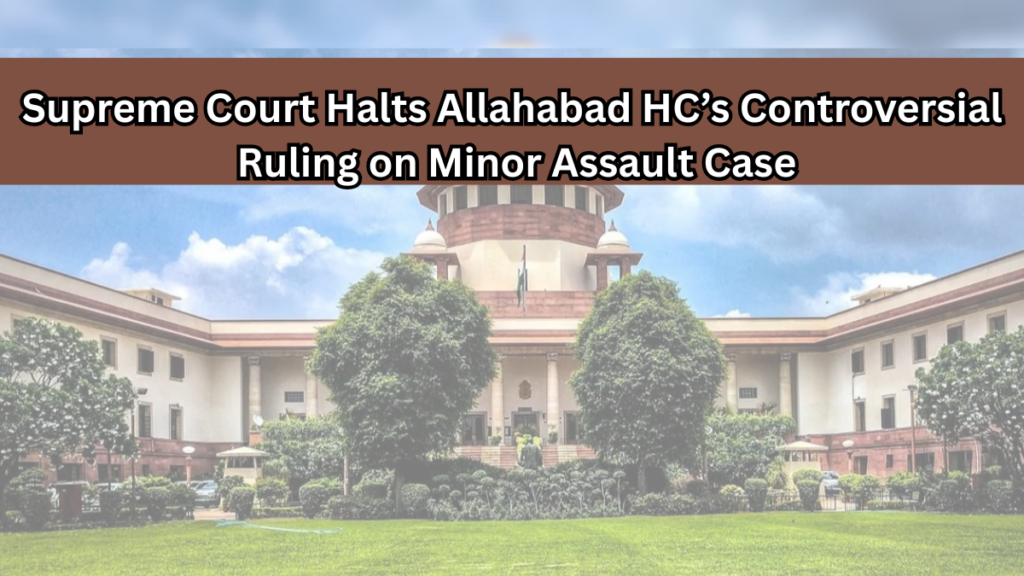In a move that has restored some public faith in the justice system, India’s Supreme Court has temporarily stayed a shocking ruling by the Allahabad High Court. The controversial judgment stated that “grabbing the breasts” of a minor girl and breaking the drawstrings of her lower garment could not be classified as an attempt to rape — a decision that stirred anger and concern across the nation.
Let’s walk through what happened, why the country is outraged, and what’s likely to happen next.

Supreme Court’s Swift and Strong Response
Recognizing the dangerous precedent the ruling could set, the Supreme Court acted quickly and firmly.
Key Actions Taken by the Supreme Court:
A bench comprising Justice BR Gavai and Justice Augustine George Masih expressed deep alarm over the High Court’s interpretation.
They called the Allahabad High Court’s March 17 judgment “shocking” — especially noting that it was reserved for four months, meaning it wasn’t an impulsive error.
Notices have been issued to:
The Central Government
The Uttar Pradesh State Government
The Supreme Court emphasized the judiciary’s duty to protect victims and ensure just legal interpretations.
Authority Involved | Action Taken |
|---|---|
Supreme Court | Stayed the High Court ruling |
Justice BR Gavai and Augustine Masih | Expressed shock and concern |
Notices Issued To | Central Government and UP State Government |
The Heartbreaking Case: What Really Happened?
This case revolves around the assault of an 11-year-old girl — a minor, defenseless, and tragically betrayed by adults she trusted.
What the Prosecution Alleges:
Two men from the girl’s village offered her a lift on their motorcycle, winning her mother’s trust.
Midway, instead of taking her home, they stopped at a secluded spot.
One man grabbed her breasts and dragged her under a culvert, where he broke the strings of her lower garment.
Her screams alerted villagers, forcing the attackers to flee.
Despite the accused denying the charges, the young girl’s testimony and physical evidence played a vital role in the case.
Important Reminder: Cases like this underline the urgent need for robust protections for minors and stricter enforcement of sexual assault laws.
The High Court’s Controversial Reasoning
Shockingly, the Allahabad High Court ruled that the acts in question did not amount to an “attempt to rape.” Instead, it categorized the incident as “aggravated sexual assault” under the POCSO Act — a significantly lighter charge.
Key Points from the High Court’s Rationale:
“Attempt to rape” requires evidence that actions went beyond preparation.
There must be a clear distinction between preparation and attempt.
Breaking the drawstring was not considered enough to prove intent to rape.
Court Ruling Aspect | Court’s Interpretation |
|---|---|
Grabbing breasts and breaking garment | Considered “aggravated sexual assault,” not “attempt to rape” |
Attempt vs. Preparation | No sufficient movement towards committing rape |
Why Many Disagree:
Legal experts argue that this interpretation ignores the psychological trauma, fear, and intent behind the assaulters’ actions. It also dangerously narrows how future courts might define “attempt” in sexual assault cases.
India’s Reaction: Outrage, Anger, and Calls for Reform
The High Court’s decision triggered immediate and fierce backlash across India — from activists, legal experts, and politicians alike.
Strong Reactions:
Senior Lawyer Indira Jaising: Argued that the incident clearly moved beyond preparation and should be seen as an attempted rape.
Minister Annapurna Devi (Women and Child Welfare): Criticized the ruling, warning it sets a dangerous precedent.
Women’s Rights Organizations: Called for an urgent legal review and judicial sensitivity toward child abuse survivors.
This case is not just about one girl. It’s about how India protects — or fails to protect — its most vulnerable citizens.
What Happens Next? The Way Forward
With the Supreme Court stepping in, there is renewed hope that justice will be prioritized over technicalities.
Possible Next Steps:
Supreme Court Review: Whether to overturn the Allahabad High Court’s ruling.
Clarifications in Law: Government may consider defining “attempt to rape” more clearly.
Stronger Child Protection Measures: Continued activism for better enforcement and harsher penalties for child predators.
Step | Potential Outcome |
|---|---|
Supreme Court Review | Ruling could be overturned |
Legal Reforms | Clearer definition of “attempt to rape” |
Child Rights Activism | Push for stricter laws and judicial reforms |
FAQs
Q1. Why did the Allahabad High Court rule that this was not an attempt to rape?
The High Court felt that the evidence showed “preparation” but not “attempt,” stating that more definitive steps toward the actual act were needed to classify it as an attempted rape.
Q2. What was the Supreme Court’s main concern with the High Court’s judgment?
The Supreme Court found the High Court’s ruling “shocking” and feared it could set a dangerous precedent that undermines the seriousness of sexual assault cases.
Q3. How did activists and officials react to the High Court ruling?
They condemned it, arguing that it downplays the trauma and intent involved, and warned it could weaken protections for minors.
Q4. What impact could this case have on Indian law?
If the Supreme Court overturns the ruling, it may lead to stronger definitions and reforms in how attempted sexual assault is interpreted legally in India.
Click here to learn more
